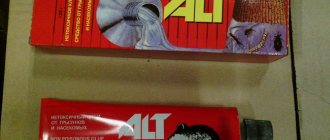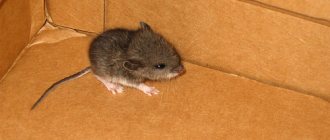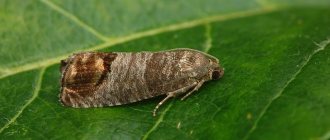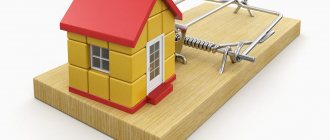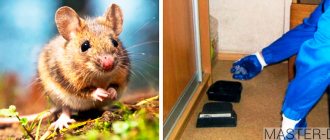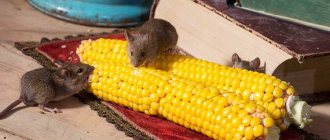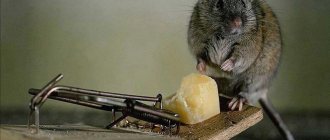Types and composition of glue
Glue in tubes must be poured onto cardboard.
Traps are available in 2 versions:
- In a tube: it must be applied to cardboard, a piece of board or other surface;
- Ready-made trap: available in the form of a plate or box, the bottom of which is covered with glue. To prevent the substance from drying out, the board is hermetically sealed.
Glue in a tube is a cheaper, but less convenient option; it is suitable if you need to make a large number of traps.
Important! Do not apply the product to wooden or porous surfaces as it will be absorbed.
The mouse sticks quickly and forever
- Polybutylene: A plastic polymer that has excellent bonding properties. Its analogue is polyisobutylene;
- Cyclosan: thanks to it, the composition remains elastic for a long time and does not dry out;
- Additional substances: rubber, resins, mineral and vegetable oils.
Using a glue trap is very simple:
- First of all, it is necessary to determine mouse trails and the places where they appear most often;
- Set ready-made or self-made traps along the route of rodents. Some compositions have an attractive smell (this will be written in the instructions) that attracts pests. If the trap does not have such an aroma, you can put a little bait in its center, but in this case the caught mouse will take longer to die, since it will be able to feed itself;
- After a few days you need to come back and see how the trap worked.
If the animal found is alive, it is better to kill it, for example, put it in several bags and tie them, then throw them away. This is a more humane option than waiting several days for the rodent to starve, and the bags will also prevent wild animals from eating the carcass.
Advantages and disadvantages
Ready-made glue traps for mice are simple and effective.
The advantages of glue against mice include:
- Ease of use: the product can be sold separately or as a ready-made trap. In the first case, the mass must be applied to cardboard or a board, in the second - simply installed near your residence;
- Safety: glue for rodents is non-toxic and not dangerous for people and pets, does not emit toxic fumes;
- No odor: the mass does not smell of anything and does not cause irritation;
- Efficiency: if the mouse gets into the mass, it will no longer be able to come off on its own;
- Long exposure time: the substance remains soft for 20 days, does not lose properties in light or heat;
- Low cost: for example, “Clean House” glue against rodents costs about 100-200 rubles.*
However, glue for catching mice also has some disadvantages:
- Still, this is not the most humane way: the mouse dies of thirst and hunger for several days, during which it will call its relatives for help. Of course, you can end her torment by killing her with your own hands, but few people will dare to do this;
- Possible danger for children and pets: upon contact with children's skin, an allergy may occur; if animals stick, you will have to
Safety precautions when handling glue
If you are already familiar with this method of control first-hand, then you probably know that there are both special adhesive compositions that you need to apply yourself, and ready-made adhesive traps, where the sticky layer is already on the substrate. From this it is clear that most often you can get dirty using products packaged in metal tubes, since contact with the material cannot be avoided.
When using glue, you must adhere to safety precautions
Here are some rules for safe handling:
- first of all, when working with glue, you need to wear rubber gloves to protect your hands;
- It’s better to also change clothes to ones that you don’t mind getting dirty;
- It is better to apply the composition to the substrate with a brush or sponge, since it stretches in thin threads that settle on everything around;
- Traps should be placed in places inaccessible to children and pets.
You need to be especially strict about the last point, because if a child or cat gets smeared in the sticky liquid, then you will have to scrub everything around. Read on to find out how to do this.
Washing glue from hands
You can wash your hands with vegetable oil, which breaks down the glue base and does not damage the skin. If it is heavily soiled, after soaking in oil, the glue can be wiped off with a pumice stone. When large elements of the glue are removed, wash your hands with dishwashing detergent or laundry soap.
You can remove stains from your hands with solvents. Acetone or nail polish remover will do. It can be used by people who are not allergic to it. It is harmless to the skin, but has an unpleasant aroma. After acetone, you need to wash your hands with regular cosmetic soap.
Description of the problem
The composition that traps small rodents is specially developed from viscous polymers that have a melting point below room temperature, so it does not harden or dry out like solutions.
In most cases, the base (up to 80%) is polybutylene with the addition of cycloisane and polyisobutylene.
The suspension can be applied to old cardboard
Polymers are not toxic, but do not interact well with weak solvents.
These glue traps are available in 2 types:
- ready-to-use traps in the form of a strip with an adhesive layer covered with a protective film for transportation;
- suspension in tubes (jar), which is applied independently to the selected base in accordance with the manufacturer’s recommendations.
Types of glue traps
The adhesive composition is specially designed to ensure instant adhesion to organic surfaces.
Specialized stores offer several types of traps:
- Ready-made boards with glue already distributed on them. The composition of the substance contains aromatic components, their smell attracts rodents. Installing the board is simple: remove the protective film and place the board in a place where active mice are observed. This is how small rodents are caught.
- Mouse glue in tubes or jars. It is difficult to apply it evenly to the selected surface yourself. Its advantages are that it does not dry out, and rats are also drawn to it. The glue should be applied to parchment paper such as magazine sheets. In practice, there are cases where a rat, having stuck its paws in the adhesive composition, and, probably, trying to get out of it, simply wraps itself in a strip of paper.
- Mouse glue. Contains the same adhesive composition; Having applied it to paper, you can sprinkle millet and any cereal crops on it. The traps work flawlessly.
Attention! You need to wear gloves to apply the glue so as not to stain your hands.
See also
Instructions for cleaning coffee machines from different manufacturers and the best products
How to remove glue - methods
Theoretically, mouse glue can end up on any surface. Pets often step into it - cats, dogs, hamsters, which stain the fur. It happens that children get into the trap and then touch furniture and other things. Glue stains can end up on your hands and clothes if you are not careful during application. Even a gadget can be damaged, fortunately, its surface has a protective oleophobic coating that repels fat and any dirt.
From the rodent itself
Many people are interested in how to wash mouse glue directly from the rodent itself. Once the pest gets into the trap, it immediately gets dirty.
Sunflower oil is often used to remove sticky residue from the pest's fur. Apply a little oil to the contaminated areas and wait 10 minutes.
Then, using a natural cloth, wipe the treated area. To remove residual oil from the fur, you should wash the rodent with plain soap.
There are other ways to clean mouse glue from a cat or mouse.
The following remedies will help remove any remaining sticky substance from the pest’s fur::
- alcohol;
- perfume;
- vodka;
- cologne.
A piece of cotton wool is moistened with the substance and applied to the contaminated area. Next, the animal is washed with soap or shampoo.
How to remove mouse glue from the floor?
Since sticky rodent traps are installed on the floor, there is always a chance that the floor will get dirty - the animal can turn the trap over, smear the substance, and you yourself can overdo it with a layer, resulting in excess ending up on the floor. The glue formula is designed so that the substance does not dry out for a very long time under any conditions, so you will most likely find the stain still liquid.
The biggest problems will arise with carpeting (the same for short and long pile), in which case the damage is easier to disguise than to remove. It will be much easier for owners of wooden floors and parquet flooring - you can interact with hard materials in much more ways.
So, two popular ways to clean mouse glue from the floor:
- Water and lemon juice. Take a liter of warm water and squeeze at least two whole lemons into it. Moisten a rag with the resulting mixture and vigorously wipe the affected area.
- Water and laundry soap. An old method that helps in situations with any difficult stains. Grate a single piece of laundry soap and dissolve these shavings in hot water. Wait for the water to cool slightly and rub the stain until it is removed.
These are quite gentle methods, since the floor and parquet are usually covered with a layer of paint, which is difficult or impossible to return to its place after cleaning. There are other options for getting rat glue off the floor, but they are suitable for cheaper and more durable flooring. For example, linoleum.
Wood
Popular ways to clean wooden floors from traces of mouse glue:
- Water with citric acid. For 1 liter of warm water take 2 tablespoons of lemon. Using the resulting solution with a hard sponge, you can remove the dirt by vigorously rubbing the area where the glue gets in contact.
- Water with laundry soap. A method that removes even dried stains. Soap dissolves in hot water; use a hard sponge to rub the stain vigorously until it is completely removed.
These are gentle methods because the wooden floor is usually painted, and you need to preserve the staining.
We wash glue from linoleum
Linoleum is softer than other floor coverings such as wooden parquet or laminate. This is its advantage and disadvantage at the same time - soft material adheres more strongly to the substance, but suffers less when trying to clean it. Linoleum will hardly suffer from attempts to remove mouse glue with alcohol, while other coatings may be permanently changed, and not for the better.
Take pharmaceutical alcohol (the higher the degree, the better), dampen a rag with it and wipe the stain with force. If there is too much substance, then first try to remove the excess with some unnecessary hard object or a construction spatula. The main thing is not to smear them over an even larger surface.
How to clean a cat from a mousetrap?
When a cat gets caught in mouse glue, the first thing to do is cut off the hair stuck to the glue. This procedure should also be carried out in case of contamination with non-adhesive toxic substances, which wool absorbs well.
Then, the skin that has been damaged by glue must be treated with vegetable oil; butter will also work. This action will weaken the damaging effect of the glue. It is strictly forbidden to use citrus oil, eucalyptus and sandalwood, such oils can only aggravate the situation. Also, in this case, you should not use flea shampoo to wash the cat, which can enhance the effect of the glue. Solvents can cause irreparable harm to a cat, for example:
- petrol;
- kerosene;
- acetone.
Next, you need to bathe the cat. It is better to take dishwashing detergent for these purposes. In this case, household chemicals that include softening agents to be gentle on your hands would be preferable. Under no circumstances should you use harsh abrasive products. The cat needs to not only be well soaped, but absolutely all the foam must be washed off. This may take time.
After bathing, the animal must not be allowed to freeze. This can cause serious illness. You need to thoroughly dry your pet, then wrap it up and put it in a warm place. Here the cat can dry out completely and recover from stress. Particular care should be taken after such a procedure for kittens and older cats. Under no circumstances should you use a hairdryer; dry the cat with a towel. Moisture should be removed from the wool using blotting movements. After bathing, you need to wrap your cat in another dry towel. The wrapped cat should be placed in a warm place, near a radiator or heater, and wait until it dries completely.
Many toxic substances are very dangerous, especially if swallowed. Usually the first signs of poisoning appear in the first twelve hours. If there are no such signs, the cat is healthy. But, best of all, for prevention, monitor it throughout the day.
What to do if your cat is poisoned?
If you are unlucky and your cat develops symptoms of chemical poisoning, you must urgently call a veterinarian for a full examination and treatment. It is strictly forbidden to induce vomiting in a cat, as chemicals can seriously damage the esophagus. There is also a chance of exposure to the lungs, which often causes serious illness. If the cat is able to drink, it is necessary to provide it with plenty of water.
Remember, in order to prevent such poisoning and problems with cleaning animal hair, it is important to use special substances to combat mice. Our company’s specialists will tell you in detail which means are best for eliminating rodents if there are pets in the house.
ATTENTION! Due to the rise in prices of drugs, cases of fraud involving the use of low-quality toxic drugs that cause allergies and other diseases have become more frequent. Be careful, cheap does not mean good!
How to wash your hands
Take a piece of cotton or linen fabric, soak it in a solvent such as acetone, alcohol or kerosene and try to scrub it off; after 2-3 minutes, wash your hands thoroughly with laundry soap and warm water. The disadvantage of this method is the adverse effects of chemical substances on the skin and the presence of a pungent odor. If you decide to use this approach, then make sure that the room is well ventilated or even carry out the manipulation outdoors. If an allergic reaction occurs, immediately stop contact with the allergen and rinse with plenty of running water.
The second, more gentle and safe method is to use vegetable oil for purification. It does not have a negative effect on the skin, is suitable for children, and effectively breaks down adhesive particles. Generously lubricate the contaminated area of skin with oil and wrap it in a cotton towel for at least 15 minutes, then wash your hands thoroughly under warm running water using fat-soluble liquids (soap, dishwashing detergent). The procedure can be repeated twice if necessary.
Cleaning glue from furniture surfaces
It is unlikely that you will be able to completely remove glue from furniture. Large fractions can be collected with a hard cloth, while being careful not to smear the adhesive composition, so as not to further stain the sofa or chair. Afterwards, the upholstered furniture is treated with a carpet cleaner, rubbing it in with a stiff brush. The final treatment of furniture consists of cleaning it with liquid washing powder.
It is easier to wash off the substance from furniture that has a hard surface. Natural wood is cleaned with alcohol-containing products. Plastic, glass and painted surfaces are wiped with lemon juice or laundry soap.
Washing clothes, fabrics
When installing glue traps for rodents, you need to act carefully so as not to stain the floor, furniture or clothing.
If you still find traces of mouse glue on yourself, you need to clean your clothes as quickly as possible. There is no point in removing old stains on your own; it is better to dry clean such items, while fresh stains can be washed with household chemicals or grease.
Household chemicals
Soiled items can be wiped off with household chemicals, which are intended for breaking down grease on kitchen stoves, cleaning the bathroom, and for washing glass and furniture. It is more effective to use toilet cleaners.
There is a 50/50 chance that the clothing will be restored to its original appearance.
After cleaning, clothing should not be worn immediately. It must first be washed 2-3 times with powder and rinse aid.
Fat
You can clean the glue with sunflower oil. You need to rub the stain or dip the completely contaminated area into it. When soaking the fabric, it should be kept in oil for 5-10 minutes. When the adhesive has softened, it is scraped off the clothing.
Afterwards, you need to clean the clothes from oil stains yourself or take them to the dry cleaner.
Methods for removing mouse adhesive from carpets and floors
Attempts to wash such a mixture if it gets on furniture or fabric are very difficult in practice. For this purpose, dishwashing liquid and oil are used. Although this method does not work 100%, since there is a risk of damage to the material. To remove mouse glue stains from the carpet, wash them with kerosene, after doing a test on an inconspicuous area.
Since the risk of spoiling the item is increased, it is best to seek help from a dry cleaner. Its employees have all the tools and skills needed to professionally remove glue from furniture and clothing.
It is easier to wash the glue off the floor:
- Moisten a clean rag with alcohol and gently wipe off the substance.
- Treat the contaminated area with a solution of lemon juice and water.
- Dilute laundry soap in 1 liter of water.
- If all efforts are unsuccessful, then you can use a spatula. Excess adhesive is removed with a hard sponge soaked in alcohol.
Wooden floors can be cleaned with solvent. But if there is paint on it, then there is a risk of defects. Because of this, it is removed from painted surfaces (including plastic) using vegetable oil. The greasy film is washed off with gentle movements with a soap solution.
How to remove super glue from linoleum if all else fails (drastic measures)
Even a person with little knowledge of this matter can offhand come up with at least four or five ways to remove adhesive residues.
Most often the list looks like this:
- Acetone, alcohol mixed with water and acetic acid;
- Any solvent available on the farm;
- Detergent, including laundry soap and jeans detergent;
- Branded products for removing paint and oil stains;
- Sunflower oil and hydrogen peroxide.
It is clear that all of the listed means, to one degree or another, allow you to remove some of the glue and paint, especially if these are fairly common dyes used in home repairs. The problem is to clean the adhesive from linoleum from the floor without damaging the coating and without spending the whole daylight hours on the removal procedure. Therefore, choosing technology and means that allow you to best remove glue from linoleum must take into account the chemical nature of the adhesive mass.
Oddly enough, the greatest number of fears and problems arise in connection with the removal of superglue. Light, very mobile liquid penetrates into the smallest pores and cracks of the linoleum coating. Therefore, it is clearly not possible to simply scrape off the stain; in addition, the material dries within a few seconds, which means that simply wiping it off with a napkin, as in the case of other types of adhesive materials, obviously will not work.
There are several ways to remove super glue from linoleum:
- White Spirit. Easily removes all brands of cyacrine compositions, but you must wear gloves, otherwise an allergic reaction of the skin of your hands is possible;
- The easiest way to remove super glue from linoleum is with branded “Anti-glue”; almost every self-respecting manufacturer of adhesive cyanoacrylate simultaneously produces products for cleaning it from various surfaces, including linoleum.
The majority of products that allow you to remove glue from linoleum are based on the same white spirit
If it is not possible to use either option, you can try to clean the glue using sequential treatment, first with acetic acid or alcohol, then treated with a small amount of castor oil. This treatment only softens the dried glue, then you just need to carefully clean the remaining cyacrine with a wooden spatula, and wash the linoleum before the castor oil causes stains to appear on the PVC layer.
In some cases, surgical intervention in the situation helps. For example, if super glue drips onto the linoleum in front of the owners, then it is quite possible to remove the stain using chemicals and reagents available in the household.
Dimexide
An aqueous solution of dimethyl sulfoxide is sold in any pharmacy under the trade name “Dimexide”. The product allows you to remove glue, but only if the stain was recently planted. Superglue adheres perfectly to slightly moistened surfaces, and is not stopped by oil, dust or detergents.
Dimexide may cause hand skin irritation
To quickly remove and wash the glue from linoleum, you need to treat the stain with a few drops of dimexide. If you don’t have one at hand, then any water-removing drug, for example, alcohol, will do. It will significantly slow down the setting of superglue, which will allow you to gain time, and sometimes simply remove the glue from the linoleum mechanically.
Straight-run gasoline, also called purified or “Galosh,” can be found in households. It is approximately equal in effectiveness to white spirit, but does not irritate the skin of the hands. Both reagents will not completely remove the glue from linoleum, but at the same time they can significantly slow down the polymerization process and soften already dried areas of the stain.
Polar solvents are most effective in removing glue from linoleum.
Gasoline and most hydrocarbon-based organic solvents can perfectly cope with most shoe and rubber adhesive compositions. For example, you can remove instant glue from linoleum, even if the stain is several days or even weeks old.
The product can be used in combination with other solvents for pentaphthalic and oil paints. But it is not recommended to use it in combination with Dimexide; the effectiveness of double use of cleaning products is significantly reduced.
Important! You should not even try to clean linoleum from glue using solvents intended for alkyd enamels and nitro paints.
Any of these reagents will most likely dissolve the outer decorative layer and lead to damage to the linoleum.
You can compensate for any solvent spilled on linoleum with regular oil.
High concentration ethanol can be used to remove traces of a wide range of adhesives. For example, alcohol will help remove mouse glue from linoleum. Moreover, alcohol compositions with a strength of 70-96% allow you to clean any floor materials without harming the decorative coating.
We suggest you familiarize yourself with How to properly widen tight trousers in the waist and sides and stretch out shrunken items after washing
If traces of glue do not come off the first time, then it is quite possible to clean the dirt on the surface of the linoleum with the help of a small compress placed on the remaining adhesive mass for 10-15 minutes.
Alcohol removes everything from linoleum except paint
Acetone
A very strong solvent, if used improperly, can lead to destruction and washing out of paints on the surface of linoleum. You can clean Moment or Cosmofen with acetone, but handling the reagent requires special care. Firstly, the solvent evaporates quickly, and inhalation of vapors can lead to poisoning, and secondly, the cleaner dries out the skin of your hands.
The procedure for cleaning traces of glue from linoleum is as follows:
- Use laundry soap to circle the stain to prevent acetone from getting on the clean surface of the linoleum;
- Place a swab moistened with acetone on the stain;
- After 10-20 minutes, remove the compress, add alcohol and remove the remaining glue mechanically.
A mixture of alcohol and acetone can effectively remove adhesive from tape from linoleum. Different brands of coating use different proportions, so before you get down to business and try to remove linoleum glue from the floor, it would be best to practice on the remaining piece of linoleum panel.
Scotch tape marks are easily washed off with a VD-shkoy
After you have tried all possible chemicals and methods for removing super glue, you can use the oldest and most reliable method. A stain of any size, even from the strongest and most durable adhesive compositions, can always be removed with a regular knife.
Most often, a scalpel, a safety razor blade, or a sharp hacksaw blade for cutting metal is used for scraping. The process is quite long, but if you combine scraping with periodic heating and cooling of the stain, you can remove a drop of superglue in just a couple of hours.
It is unlikely that you will be able to completely remove glue from furniture. Large fractions can be collected with a hard cloth, while being careful not to smear the adhesive composition, so as not to further stain the sofa or chair. Afterwards, the upholstered furniture is treated with a carpet cleaner, rubbing it in with a stiff brush. The final treatment of furniture consists of cleaning it with liquid washing powder.
It is easier to wash off the substance from furniture that has a hard surface. Natural wood is cleaned with alcohol-containing products. Plastic, glass and painted surfaces are wiped with lemon juice or laundry soap.
Sometimes rodents caught in a trap turn it over
Careful adherence to the rules specified in the instructions does not always free you from deciding how to wash glue from mice from the floor or other hard objects.
This option can be prevented by nailing the trap or securing it securely in a suitable way.
We suggest you read: How to get rid of mice in a private house, how to deal with mice in a private house: a remedy for mice in the house, what are mice afraid of in the house, folk remedies
Contaminants can be easily washed off with the solvents specified on the manufacturer's packaging. You may have an analogue at hand, on which GOST or just the brand is indicated.
When installing glue traps for rodents, you need to act carefully so as not to stain the floor, furniture or clothing.
Household chemicals
Soiled items can be wiped off with household chemicals, which are intended for breaking down grease on kitchen stoves, cleaning the bathroom, and for washing glass and furniture. It is more effective to use toilet cleaners.
After cleaning, clothing should not be worn immediately. It must first be washed 2-3 times with powder and rinse aid.
You can clean the glue with sunflower oil. You need to rub the stain or dip the completely contaminated area into it. When soaking the fabric, it should be kept in oil for 5-10 minutes. When the adhesive has softened, it is scraped off the clothing.
Afterwards, you need to clean the clothes from oil stains yourself or take them to the dry cleaner.
If, through carelessness or an absurd accident, glue gets on fabric material, furniture or carpet, the best step would be to resort to dry cleaning services. If you still want to clean clothes, curtains, and upholstered furniture at home, take the advice of some housewives and wash things with sunflower oil, but after that you will have to solve a new problem - greasy stains.
How to remove glue using different means
Sticky traps for rodents are installed in places where they regularly appear. An animal caught in them will try to escape from the trap, turning it over and resting against interior items. In this case, the adhesive composition will stain everything in the area. During cleaning, mouse repellent can get on clothes, and active pets can easily stain their fur with it, since the composition in the glue trap remains liquid for a long time.
Vegetable oil
Every housewife has sunflower oil in her kitchen. They can be used to remove glue from clothes at home; to do this, the stain is smeared with oil or the completely contaminated area is dipped into it. Soak the fabric in a bowl of oil for 5-10 minutes, then carefully scrape off the adhesive mixture. All actions are carried out with gloves.
The fatty base of the oil breaks down the components of the mixture, after which the clothes are easy to clean. If the contamination is severe, oil cleaning must be repeated.
The disadvantage of this method is that after this you need to remove greasy stains from clothes. This can be done with warm water and laundry soap.
Vegetable oil has no effect on human skin and completely removes adhesive residues. If the fur of a pet is dirty, you can lubricate it with vegetable oil and remove any remaining dirt with a comb. After this, the animal must be bathed in a soapy solution.
Dish detergent
Dishwashing detergent will help remove rodent glue. They are used during secondary processing, when lumps of the substance have already been removed from animal hair, clothing or other fabrics. Dish detergent is used instead of shampoo when bathing your pet. They wash off greasy stains from fabric surfaces.
Kerosene
This is a highly effective product, the disadvantage is that the skin of your hands dries out when working with it. After cleaning the surface with kerosene, your hands should be smeared with a rich cream with a nourishing effect. All work is carried out with gloves outdoors, as toxic fumes are released.
When using kerosene products, you need to remember that the smell can be removed from clothes only after several washes.
Lemon juice
Lemon juice not only helps remove mouse glue, but also removes grease stains. It is not pure juice that is used, but its solution. To prepare the cleaning product, take a glass of warm water, to which 2-3 tablespoons are added. fresh lemon juice. The composition removes adhesive stains from fabrics and hands. When cleaning clothes, soak them in diluted lemon juice for 5-6 minutes, then wash them using the usual method.
Laundry soap
You can use soap to remove the adhesive from the floor covering. A sponge rubbed with laundry soap removes sticky residue on laminate and linoleum. Contamination from hands is first removed with vegetable oil and then treated with a soap solution. This method can be used to wash off glue from children's hands.
How to remove mouse glue from a cat?
Cats can be attracted to the trap by a tasty-smelling bait (a piece of cheese or sausage, for example) or by the mouse itself, which has already fallen into the trap. The cat will not see the threat in the substance and may get very dirty. A pet can even carry away an empty trap on a piece of cardboard or thin wood, being very frightened.
- Catch your pet and assess the situation to understand how to remove mouse glue from the animal.
- If the affected area is too large and the trap is completely stuck to the fur, take scissors and cut it off first.
- Try to grab as little hair as possible and do not try to tear off the hairs - this can injure the cat.
- If you are not sure of your accuracy and there is nothing in the house that can be used to remove mouse glue, or the trap is stuck too close to the skin, take the animal to the veterinarian.
Do not try to wet the wool in an attempt to soften the glue. There is no way to remove mouse glue from a cat's fur; you will only add unnecessary stress to your pet.
If the cat has entered the trap with its paw, use a method similar to the method for human skin - hold the pads in oil. Then try to wipe off the sticky layer with a rag or soft sponge. After removing the main stain, clean the residue with soap or dish detergent.
We wash the kitten from mouse glue using the video:
Hard case
The performance characteristics of mouse glue are specifically designed to instantly adhere to organic surfaces.
For the skin of the hands, exposure to these liquids in small quantities is usually acceptable, but removing the sticky mass from hair, pet fur, or fabric upholstery in this way will be not only difficult, but also practically impossible.
Safe ways to remove sticky glue from hair are:
- A haircut. If only the ends of long hair (wool, lint) are dirty, then it is better to trim them carefully, since treatment with synthetic or organic liquids will cause more damage to the undamaged part. It is recommended to choose this method for pets as well, otherwise it will take a lot of patience for both the pet and the owner while washing off the glue.
- The use of natural solvents (sunflower oil) and/or household chemicals. This is a more labor-intensive process, since it is necessary not only to remove dirt, but also to remove oil and synthetic detergents that are absorbed into the skin and hair. Grease removers (for example, dishwashing liquid) are used from household chemicals.
Oil will remove glue residue well, but not always the first time
Oil not only dissolves polymers, but also activates the process of self-cleaning of living tissues (the work of the sebaceous glands) and then mechanical removal of the adhered mass occurs along this film, so it is not always possible to remove the stain the first time.
READ MORE: Floor installation in a private house without a basement
In such cases, use an oil compress - generously lubricate your hand and wrap it in a thick cloth for 15-20 minutes, then rinse it off with a degreaser.
Removing stains
Sometimes rodents caught in a trap turn it over
Careful adherence to the rules specified in the instructions does not always free you from deciding how to wash glue from mice from the floor or other hard objects.
A large animal, caught in a trap, can turn it over and drag through the bar with the sticky mass.
This option can be prevented by nailing the trap or securing it securely in a suitable way.
On store shelves you can find the following types of rodent traps:
- The finished board on which it is applied. This substance contains components that attract mice with their smell. The mousetrap board is very easy to install. After removing the protective film, it is placed on the surface in a suitable place.
- In cans and tubes. In this case, there is a problem of uniform distribution. But there are also advantages - the product does not dry out, despite a certain room temperature.
It should be noted that, applied to cardboard, it can only be used once. After a mouse gets into it, such a trap is thrown away to prevent the animal from starting to decompose.
In other cases, millet and sometimes other grains are scattered on top of the cardboard. These traps are placed where mice appear most often.
These rodent mouse traps are also available to inquisitive pets. For this reason, the glue remaining on the paws and fur ends up spreading throughout the apartment. The usual way to wash a cat off the mouse sticky substance will not work. For this purpose, use vegetable oil, applying it to the fur of a dog or cat. Then, you should wash the animal with either laundry soap or dishwashing detergent.
The same procedure is carried out in veterinary salons or clinics. In a short time, employees of such organizations remove it without harm to the health of the animal.
Attempts to wash such a mixture if it gets on furniture or fabric are very difficult in practice. For this purpose, dishwashing liquid and oil are used. Although this method does not work 100%, since there is a risk of damage to the material. To remove mouse glue stains from the carpet, wash them with kerosene, after doing a test on an inconspicuous area.
Since the risk of spoiling the item is increased, it is best to seek help from a dry cleaner. Its employees have all the tools and skills needed to professionally remove glue from furniture and clothing.
It is easier to wash the glue off the floor:
- Moisten a clean rag with alcohol and gently wipe off the substance.
- Treat the contaminated area with a solution of lemon juice and water.
- Dilute laundry soap in 1 liter of water.
- If all efforts are unsuccessful, then you can use a spatula. Excess adhesive is removed with a hard sponge soaked in alcohol.
Wooden floors can be cleaned with solvent. But if there is paint on it, then there is a risk of defects. Because of this, it is removed from painted surfaces (including plastic) using vegetable oil. The greasy film is washed off with gentle movements with a soap solution.
Since its composition, when handled with it, can get on your hands, housewives want to know how to safely remove it from the skin. Usually either cotton or linen fabric is used.
A solvent, kerosene or nail polish remover containing acetone is applied to the material. Due to the pungent odor and bad effect on the epidermis of the hands, this method is considered not very popular.
Therefore, you can resort to using vegetable oil, for example, sunflower. This product dissolves glue without harming the skin. To do this, cover the area generously with oil, wrap it in cloth and leave it alone for 30 minutes. Then, using laundry soap or dishwashing liquid, rinse everything thoroughly with warm water.
The advantage of this method is that there is no negative effect on the skin, and mouse glue is removed 100%. If necessary, the procedure can be repeated.
How to wash your hands
For skin, contamination from mouse glue is comparable to contact from superglue. Hands are cleaned with vegetable oil; it dissolves the adhesive and does not harm the skin.
You can rub the stained area with pumice stone when the adhesive composition becomes wet under the influence of oil. Then you need to wash your hands with laundry soap or any dish soap.
Another way to clean mouse glue from your hands is to wash off the stains with acetone. It is harmless to the skin, the only downside is the strong smell. Afterwards, you can wash your hands with regular cosmetic scented soap to get rid of the unpleasant odor.
Attention! Acetone is not used by people with allergic reactions.
One of the popular budget methods of rodent control is the installation of glue traps. The disadvantage of traps is that in addition to pests, people or pets can get dirty with the adhesive mixture. If the trap is not used carefully, the product ends up on the floor, furniture, clothing, and other surfaces. You can wash mouse glue using natural and chemical substances.
conclusions
- Place the trap away from children and animals.
- Warn your family about it.
- Apply mouse glue carefully and do not place it near upholstered furniture.
- Such sticky substances must be handled like superglue, or even more carefully.
Sources
- https://dr-dez.ru/myshi-i-krysy/chem-otmyvaetsya-klej-ot-myshej.html
- https://KiguHome.ru/sovety/chem-otmyt-myshinyj-klej.html
- https://felisov.ru/tarakany/chem-otmyt-klej-ot-myshej.html
- https://kraska.guru/klej/udalenie/chem-otmyt-klej-dlya-myshej.html
- https://parazitdoma.ru/krysy-i-myshi/chem-otmyt-kley-dlya-myshey
- https://dezplan.ru/vopros/chem-otmyt-kley-dlya-myshey-1
- https://hozzi.ru/chistka/chem-otmyt-klej-dlya-myshej
- https://stop-insect.ru/articles/chem-otmyivat-kota-ot-myishelovki,-chtobyi-ne-povredit-sherst.html
- https://KraskaGuru.ru/klej/poklejka/otmyt-lovushku-dlya-myshej.html
- https://DomStrouSam.ru/kak-i-chem-otmyt-klej-ot-myshej-s-pola-mebeli-a-takzhe-s-ruk-i-shersti-zhivotnyh/
[collapse]
